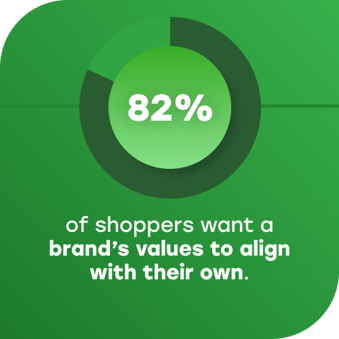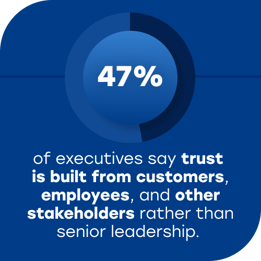Building Trust with Consumers: Why Quality Audience Data Matters in Purpose-Driven Marketing

Adam is Tunnl's Director of Business Development. He joined the team in February of 2022.
 A recent study on consumer trust revealed a shocking misunderstanding. While 87% of executives think consumers have a high level of trust in their business, only about 30% of consumers agree.
A recent study on consumer trust revealed a shocking misunderstanding. While 87% of executives think consumers have a high level of trust in their business, only about 30% of consumers agree.
And when consumers lose trust in your company, they take their business elsewhere.
Purpose-driven marketing gives brands a way to connect with consumers on a more personal level, connecting companies’ values to those of their supporters to create lasting bonds.
But without the right audience data informing your outreach, purpose-driven marketing can have the opposite effect.
Built by public affairs and microtargeting pioneers to help advertisers find success in today’s issue-concerned climate, Tunnl understands the crucial role audience data plays in the world of brand reputation management and purpose-driven marketing. You need accurate insights about your audience if you want to earn and maintain their trust.
We’ll walk you through how emotional, empathetic connections can be created - or destroyed - based on the audience data you use to inform your purpose-driven marketing campaigns, so you can decide if this powerful trust-building strategy is right for your organization.
What is Purpose-Driven Marketing?
Purpose-driven marketing is an external communication strategy that aligns an organization’s values with those of its target audience to build trusting, long-term relationships with customers. When consumers see themselves in your brand, they believe in you and buy from you.
 The purpose-driven marketing approach has gained some momentum with advertisers and consumers alike in recent years. Consumer research from The Harris Poll in partnership with Google Cloud revealed that 82% of shoppers want a brand’s values to align with their own, and if they don’t, about three-quarters of the consumers polled would pick a compatible competitor instead.
The purpose-driven marketing approach has gained some momentum with advertisers and consumers alike in recent years. Consumer research from The Harris Poll in partnership with Google Cloud revealed that 82% of shoppers want a brand’s values to align with their own, and if they don’t, about three-quarters of the consumers polled would pick a compatible competitor instead.
Consumer behavior like this underscores the risks and rewards of purpose-driven marketing. While a public display of your brand values may endear some consumers to you, the campaign may also signal to other consumers that your brand is not for them.
So is purpose-driven marketing really a worthwhile way to build trust with consumers?
Does Purpose-Driven Marketing Work?
Trust is easy to lose and difficult to regain. Any advertising strategy that damages your brand’s reputation with consumers or loses your organization money deserves its spot in the wastebasket.
But purpose-driven marketing is a profitable long-term marketing strategy that pays dividends when done right. 
Consider brands like Chick-fil-a and Patagonia. Though they couldn’t be more different from each other, they have purpose-driven marketing success in common. Both brands have clear, sometimes polarizing values, but they have maintained consistent popularity with consumers, especially the shoppers who agree with their respective stances on family values and environmentalism.
Consumers want to know where your organization stands, for better or worse.
Whether purpose-driven marketing will work for your organization is a matter of cost-benefit analysis - and you have to think long- and short-term. Though you may lose a smattering of customers when you begin advertising on your company’s values, the high lifetime value of the customers you gain and retain could be well worth it.
“If that comes with not attracting a particular customer, that is a price that you have to pay, but again, think of that future customer - the Millennial or Gen Z; You’re probably in line with them,” says Stephanie Cutter, Founding Partner at Precision and panelist for Tunnl’s A Data-Backed Discussion on the Future of ESG in America webinar, covering the increasingly polarizing environmental, social, and governance policies of businesses and governments throughout the country. “It’s not about this quarter. It’s not about the latest Twitter conversation. It’s about your long-term strength as a company.”
Your organization could have a lot to gain from purpose-driven marketing, but not every marketer who has ventured into the purpose-driven marketing arena has seen success. The quality of the audience data used in your campaign often sets the tone for how successful your campaigns will be.
What Does Audience Data Quality Mean?
Audience data quality refers to the accuracy, consistency, and reliability of data throughout its lifespan. High-quality audience data is always up-to-date and secure, giving advertisers confidence that they are reaching the right people with their campaigns.
Why Audience Data Quality Matters in Purpose-Driven Marketing
For purpose-driven marketers, audience data quality is of the utmost importance because opinions shift quickly, and value-based targeting needs to be accurate to preserve consumer trust. Audience data can help marketers and advertisers understand their target audience better and identify groups with symbiotic values, known as issue-based audiences.
It’s critical that purpose-driven marketing campaigns strategically incorporate issue-based audiences that are often refreshed to keep up with changing consumer sentiments and emerging issues related to your organization’s values.
Otherwise, you have a lot to lose.
 Inaccurate, out-of-date, or otherwise low-quality audience data could put your campaigns at risk of being ineffective or counterproductive in bolstering consumer trust. Consider the recent scandals of Bud Light and Target. Their purpose-driven campaigns missed the mark with their broad supporter bases, costing millions and sparking civil unrest among the most disgruntled customers. Instead of building trust, these campaigns earned boycotts and vandalism.
Inaccurate, out-of-date, or otherwise low-quality audience data could put your campaigns at risk of being ineffective or counterproductive in bolstering consumer trust. Consider the recent scandals of Bud Light and Target. Their purpose-driven campaigns missed the mark with their broad supporter bases, costing millions and sparking civil unrest among the most disgruntled customers. Instead of building trust, these campaigns earned boycotts and vandalism.
There are right and wrong ways to connect with consumers’ values if you’re going to give purpose-driven marketing a try. Audience data and what your organization understands about your audience are the keys to avoiding purpose-driven marketing disasters.
The Dos and Don’ts of Building Consumer Trust with Purpose-Driven Marketing
Setting out to establish trust with consumers through purpose-driven marketing is a powerful marketing move, and one that requires a strong sense of accountability.
As we’ve established, there are risks and rewards to purpose-driven marketing, and audience data can be the deciding factor in which side you end up on. With data on your side, it’s easier to take ownership of your campaigns and drive a purpose-driven culture throughout your organization.
And you’d be defying the norm by doing so.
According to Trust: the new currency for business, a recent PwC survey on trust, there’s a lot of finger-pointing when it comes to who should own the task of fostering trust between company and consumer.
“In our current survey, 47% of executives say trust is more bottom-up than top-down, built from customers, employees and other stakeholders rather than senior leadership. Only 27% of customers and 35% of employees say the same, indicating that they are looking to the C-suite to lead more on trust.”
We believe it takes collaboration to create a campaign that resonates with and represents everyone in your organization’s trust ecosystem. If you’re going to do that, you need audience data on your side to help you tread confidently and carefully through every step of campaign planning and optimization.
And that brings us to the first set of dos and don’ts in purpose-driven marketing planning, assessing your audiences’ values.
1. Assess Your Audiences’ Values
To accurately predict how beneficial purpose-driven marketing will be for your organization, you need to consider how compatible your values are with your target audience.
Don’t - Plan Your Campaigns in a Silo
You may think you understand the values of your target audience and current customers, but assumptions are costly risks in disguise. Audience data needs to substantiate your beliefs about your audience and needs to include everyone whose trust is instrumental to your company's success.
That may mean reaching out to more than just customers.
“You need to know about your customer base, and you need to know about your employee base and anyone else that matters to you before you engage on these issues,” says Brent Seaborn, Tunnl’s Chief Data Science Officer. “Prioritize learning what motivates or persuades your target audience when it comes to these topics before you put dollars behind a campaign on the issue.”
Gathering a cohesive understanding of all of your audiences may require collaboration beyond your marketing department, but getting everyone on the same page ensures cohesive messaging that doesn’t isolate the groups you serve.
Do - Understand Your Entire Audience
 The divide between public affairs and marketing departments is disappearing. Neither have the luxury of staying in their respective lanes anymore, one advocating for industry-relevant issues and the other supporting revenue generation. The two departments need to collaborate connect with consumer values, advocate for change, and present a cohesive identity to everyone watching.
The divide between public affairs and marketing departments is disappearing. Neither have the luxury of staying in their respective lanes anymore, one advocating for industry-relevant issues and the other supporting revenue generation. The two departments need to collaborate connect with consumer values, advocate for change, and present a cohesive identity to everyone watching.
That’s no small feat, but it starts with understanding everyone in your audience.
“You have to look at it holistically,” advised Stephanie Cutter during A Data-Backed Discussion on the Future of ESG in America. “You have to look at all the audiences that you’re serving.”
Determine what your current customers, ideal customers, employees, leadership, and shareholders value. This will require some audience intelligence gathering, but provides a solid baseline for next steps in cultivating a purpose-driven marketing strategy.
2. Set Your Values
Before you can connect with consumers on shared values, you need to clearly define what your organization stands for.
Don’t - Let Trends Determine Your Values
Issues tend to trend in and out of the spotlight. Resist the urge to design purpose-driven marketing campaigns based on what's trending, especially if the values are incompatible with your brand.
“We believe that people - and therefore consumers, shareholders, investors - don’t care if you pick a side,” says Alex Schriver, Executive Vice President and Head of Public Affairs at Targeted Victory, while commenting on the esteemed reputations of Chick-fil-a and Patagonia during Tunnl’s webinar: A Data-Backed Discussion on the Future of ESG in America.
“They mind if you pick and choose sides based on the Twitter mob of the day.”
Do - Be Authentic
Authenticity is a pillar of trust. When you launch purpose-driven marketing campaigns, you want consumers to see your ads and think, “That makes sense,” rather than, “Who are they kidding?”
Using what you know about your audiences and company goals, consider what your organization truly stands for. Define your “why.” What purpose, other than generating revenue, is your organization serving?
As you think about what your company represents, how it fits into the lives of consumers, and what the organization is hoping to achieve, your genuine company values should become more apparent.
3. Embody Your Values
With your values established, you have to act accordingly - and consumers are watching.
Don’t - Contradict Your Values
A main tenant of building, maintaining, and growing consumer trust is consistency. If you act against your stated values, consumers will stop believing you, and likely stop buying from you as a result.
Do - Act with Integrity
 Because you are developing purpose-driven marketing campaigns around values rooted in the reality of your organization, it should be easy to act in alignment with those values, right? There’s nuance to how your business operates, and the values you campaign on need to be consistently represented throughout your company.
Because you are developing purpose-driven marketing campaigns around values rooted in the reality of your organization, it should be easy to act in alignment with those values, right? There’s nuance to how your business operates, and the values you campaign on need to be consistently represented throughout your company.
Keep public affairs in mind - and involved in planning meetings - as you develop your campaigns.
4. Prioritize Optimization
Purpose-driven marketing requires an agile strategy and a keen eye for how consumer sentiments are changing.
Don’t - Get Complacent
The audience data you rely on to plan your initial campaign needs to be iron-clad, accurate, and reliable - but even the best data has an expiration date in purpose-driven marketing. To reach people who align with your values, you need to keep tabs on who moves in and out of your target audience as consumer sentiments shift.
Fail to target your purpose-driven marketing campaigns accurately, and you’ll end up hemorrhaging ad spend to reach people who don’t care about your message.
Setting and refining your audience targeting parameters is an ongoing process that keeps your campaigns on the right track.
Do - Use Up-to-Date Audience Data
.png?width=328&height=247&name=Audience%20Landing%20Pages%20Body%20Picture%20(13).png) As election cycles ebb, global events get splashed across headlines, and people consume influential media, the issues that take center stage in their hearts and minds change. It can happen fast, and your audience data needs to keep up.
As election cycles ebb, global events get splashed across headlines, and people consume influential media, the issues that take center stage in their hearts and minds change. It can happen fast, and your audience data needs to keep up.
Purpose-driven campaigns can only achieve maximum efficiency and effectiveness if they are targeted to the right people, people who align with your views and care about the same causes.
Base your campaigns on a frequently refreshed audience data source to ensure the audience insights are always accurate and up-to-date.
Start Using Audience Data to Build Trust with Consumers in Your Purpose-Driven Marketing Campaigns
Purpose-driven marketing is a fast track to consumer trust if you have the right data to inform your campaigns.
And to find always accurate, up-to-date, issue-based audiences that speak directly to the values you share with your customers, look no further than Tunnl’s extensive library of prebuilt audiences. The data we offer empowers you to confidently appeal to the values and issues that resonate most with your audiences without fear of wasting your ad budget on the wrong people.
Using Tunnl to guide your outreach puts you in the powerful position to empathize and connect with customers old and new, bettering the long-term outlook of your company one purpose-driven marketing campaign at a time.
Don’t see your issues or interests represented in our hundreds of prebuilt audiences? Consider a custom audience created unique to your niche.



